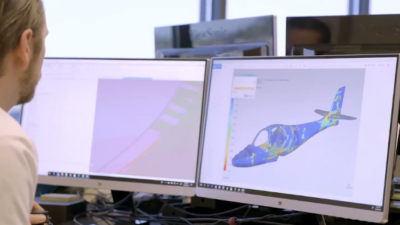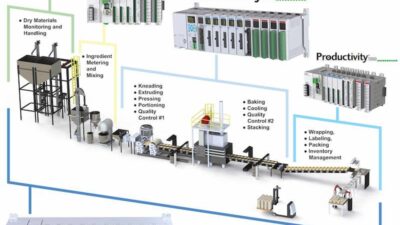Worldwide, 30-odd companies are developing and marketing computer-aided manufacturing (CAM) software. That is almost unique in any mature business—and is increasingly unsustainable. Consolidation, viewed by many as long overdue, is going to have a big impact on the men and women responsible for manufacturing engineering, and who program computer numerically controlled (CNC) machines too.
Worldwide, 30-odd companies are developing and marketing computer-aided manufacturing (CAM) software. That is almost unique in any mature business—and is increasingly unsustainable. Consolidation, viewed by many as long overdue, is going to have a big impact on the men and women responsible for manufacturing engineering, and who program computer numerically controlled (CNC) machines too.
Why now? Demands on programmers, and thus on CAM capabilities, are escalating. The pressures include ever-shorter production runs (more programs are needed to keep the business humming), more engineering changes to be dealt with in less time, and more interruptions for prototypes. Global competition has created thinner margins and no leeway for error.
On the vendor side, complex and pricey new machine tools are putting new demands on programmers and CAM. The development of a two types of CAM vendors—those that have tight digital links to solid modelers for machining from the solid, and those that don’t—is producing added pressure. Solid modeling has driven two-dimensional and wireframe computer-aided design (CAD) almost completely out of design and engineering.
The coming consolidation will be led by large CAM vendors with global reach, by developers of solid-modeling systems and by product lifecycle management (PLM) software companies. It will make a transition to CAM easier for users, because the surviving CAM companies will realize, as Planit has, that the basis of competition is shifting strongly toward customer service.
But CAM users and customers have a role to play too. All demand a broad portfolio of products from a single supplier like Planit (and its business units EdgeCAM, Radan, PartModeler) and other leading suppliers. They tell us they are happy with the products and services, and that they are willing to turn a sales relationship into a partnership with many added benefits. But many don’t follow through. They don’t send their users to advanced training to learn to use these tools.
If there is a disconnect in the CAM business, this is it. And that disconnect may grow bigger as customers increasingly demand all kinds of production data to feed PLM and enterprise resource planning (ERP) systems.
Fortune 1000 manufacturers, defense contractors, regulated companies, and their counterparts worldwide already demand that these information loops be identified and closed tightly. Most insist that parts suppliers “get with the program” and use the CAM products that are available. Those that can’t or won’t are dropped. So let’s take a deeper look at how CAM is used and assess the second-order benefits, the ones that accrue to the business as a whole.
CAM allows a company to:
-
Safeguard design intent by eliminating all redrawing of geometry.
-
Eliminate errors that cause rework or scrap by verifying CNC toolpaths.
-
Slash delivery times and simplify operations by minimizing machine-to-machine transfers and setups.
-
Integrate inspection and quality assurance.
-
Generate accurate time estimates and avoid collisions by simulating processes.
-
Get the best from skilled workers by increasing their productivity.
-
Evaluate workarounds for avoiding production bottlenecks and optimize key equipment.
All these factory floor innovations lead directly into tools and techniques that the front office can put to work this afternoon or next Monday morning to improve the business. In this environment, the robust and well-financed CAM-using companies that capture the information underlying these second-order benefits—and present it usefully—will survive.
Benefits from these bullet points are invaluable to every user of CAM—original equipment manufacturers, contract parts makers, tooling suppliers, and custom machinery builders. For shrewd managers, CAM information provides the best data on cost cutting and waste elimination. In world-class companies, CAM information is put to work in almost every part of a manufacturing business. In smaller companies, the benefits can be just as great.
ONLINE EXTRA
Just What is CAM, Anyway?
CAM is software for programming CNC machine tools. Like machine tools, CAM ranges from very simple to very complex. It’s used in metals-oriented systems, as well as to drive machinery for woodworking, printed circuit boards, composite materials, and systems for assembly and packaging.
In addition to the ubiquitous 3-axis milling-machine CAM, there are the following types:
• 2-axis, for basic turning and grinding plus punching, drilling, riveting, flame-cutting, shearing, electrical discharge machining (EDM), and cutoffs.
• 2-1/2-axis engraving.
• 3-1/2-axis milling for tools and prototypes.
• 4-axis turning for dissimilar operations on one part at the same time.
• 5-axis profiling and laser machining for surfaces curved in two or more directions (saddles or “potato chips”), helixes, fillets and splines.
• 6-axis robotics. In addition to X, Y and Z, robot “wrists” have roll, pitch and yaw
• 7-, 9- and even 11-axis machining, so components can be produced in a single setup—turned, milled and drilled simultaneously—or formed sequentially by bending.
Detailed CAM Benefits
CAM allows a company to:
• Safeguard design intent by eliminating all redrawing of geometry. Making CAM functionality available from within solid-modeling systems ensures that even the subtlest engineering change will not be overlooked. Programmers no longer have to search for them and changes are easily implemented in quick CAM revisions.
• Eliminate errors that cause rework or scrap by verifying CNC toolpaths. NC visualization is the best technique yet. Error-free tool paths are assured and test cuts can be skipped, worry-free.
• Slash delivery times and simplify operations by minimizing machine-to-machine transfers and setups. Job simulation addresses ways to minimize setups and transfers between machines. Prequalified tooling, fixturing and work pieces help get rid of the need for incoming inspection—and unpleasant surprises on the loading dock.
• Integrate inspection and quality assurance. Geometric dimensioning and tolerancing (GD&T) helps avoid potential disputes. When disputes do occur, the data is on hand in CAM to resolve them equitably.
• Generate accurate time estimates and avoid collisions by simulating processes.
• Get the best from skilled workers by increasing their productivity. Capturing best practices—and enforcing their reuse—goes a long way toward stamping out process variations, which are still the greatest source of manufacturing error.
• Evaluate workarounds for avoiding production bottlenecks and optimize key equipment. This means delivery promises can be relied on by everyone.
| Author Information |
| Peter Roost is marketing director for metals business worldwide at Planit Holdings Ltd. in Ashford, Kent, United Kingdom. For more information, visit |


